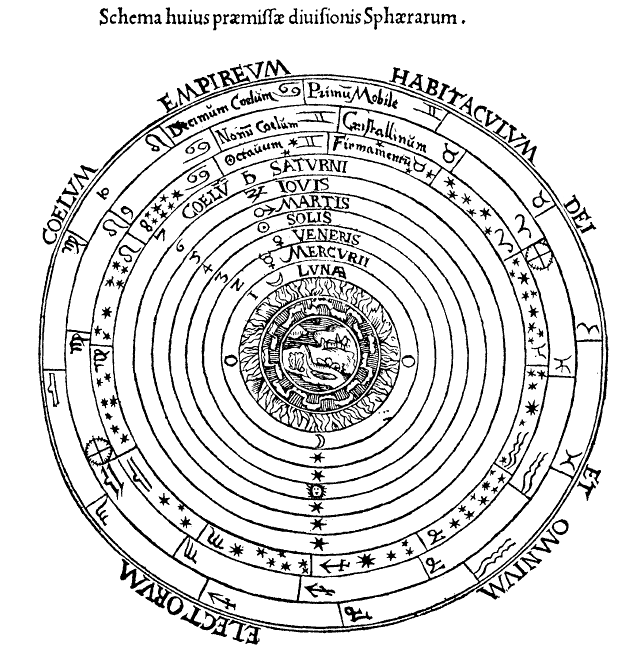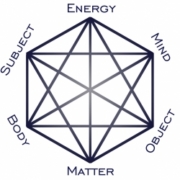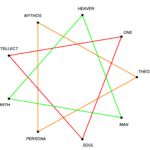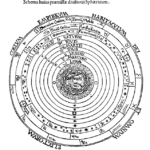On Ancient Numerology and Astronomy
In their quest for the ultimate symbols to represent reality, an integral of their philosophical pursuits, the Greeks developed an esoteric tradition that although was not inconsistent with the pantheistic tradition within which it coexisted, was relatively independent from it. It was the secret truth of religion and was not meant for everyone. Traces of these belief systems, the very foundations of Western philosophy and Science in fact, can be found in the various philosophical schools that cropped up in Hellenic antiquity, as well as in the mystery traditions, e.g. Orpheus and Dionysus. This tradition was closely guarded, not meant for the uninitiated, and it was not surprisingly influenced by their neighbors to the south (Egypt) and their neighbors to the East (Magi).
It is out of these philosophical schools of course, that emerges not only the theological foundations of Christianity, as a sort of neo-philosophical movement appended to the ancient Hebrew tradition overlaid by the larger than life figure of Jesus, but also the Gnostic schools and the Hermetic schools that laid the groundwork for the esoteric and alchemical traditions which ran parallel to Christian and Islamic orthodoxy straight through the Middle Ages up until the Enlightenment, ushering in the so-called Age of Science.
The philosophical pursuit proper can be seen through this historical lens as the intellectual search for the grounding of reality and existence using reason in and of itself, bringing together all the ‘scientific’ knowledge in antiquity, and creating schools and libraries and scholars to preserve this tradition from generation to generation. This tradition, these ancient philosophical schools which emerge in classical antiquity, represent in no small measure the great contribution of these ancient peoples to Western civilization, the term for the Academy of course gets its name from the most famous of these schools – Plato’s in Athens.
Somewhat consistently across all the differing Greek philosophical schools from classical antiquity was this search for archetypical substances, cosmogony effectively, from which the universe emerges which in turn facilitates the understanding of this universe within which we live, and perhaps more importantly, provides the intellectual basis for a system of ethics for the individual and society as a whole which to aspire to. This was the concept of arete, or excellence, which along with the notion of virtue saturated these ancient Greek philosophical schools with respect to their systems of ethics and morality.
All of them contended in one respect or another that there existed some sort of primordial ontological substance (ousia) that was indivisible and from, and from which the rest of the universe could be said to emanate, or germinate from. This was the One of the Neo-Platonists, the Monad of the Pythagoreans, the Demiurge of Plato and the unmoved mover of Aristotle. This was in fact consistent with the more archaic cosmogonical systems of belief we find across antiquity, most certainly in the West – the watery abyss, or apas of the Egyptians, or the great cosmic waters of the ancient Hebrews.
In this sense, first philosophy in antiquity all led to the same place for the most part, even if the underlying metaphysical systems writ large were unique – the nature of the Soul, nature of Free Will, Fate, the gods, etc. Many of these differences still serve as philosophical guiding posts and points of contention to this day however, so in this sense philosophy in antiquity can be seen as setting the stage, or intellectual landscape, of metaphysics and philosophy in general as we have come to understand it in the western tradition at least.
There was on byproduct of this tradition that was unique in and of itself however, and eventually branched off to its own field but in antiquity at least (and up until the Middle Ages in the scholastic curriculum) was incorporated into philosophy proper. The practice of what we might call numerology, which includes the study of and inquiry into the meaning of numbers, Mathematics in general, and the discipline of Geometry, all fields which the Greeks made significant contributions to (Pythagoras, Plato, Euclid, etc.)
But from the perspective of these ancient philosophical schools, most of which had mystical/theological bents to them, numerology and Geometry in particular, along with Astronomy, were looked upon not only as practical Sciences used for architecture, seasonal planting and harvesting, etc. but were also looked upon as mystical theological symbols in and of themselves. These were gateways to the divine in some way, gifts from Hermes to mankind for which he was severely punished.
For to the Greeks, and for the most part to the Egyptians, Persians, Chaldeans (Babylonians) and other civilizations in antiquity the Mathematics, numbers and Geometry, all of which were closely interwoven into Astronomy and philosophy proper of course, were not only considered practical tools, but also lenses through which the nature of the divine could be known, be understood, by means of which the very nature of the universe itself, resting squarely on the (mostly) Greek philosophical invention that the intellect, reason (logos), was the greatest and most singular tool of mankind. This was the great gift of the Greeks really, the logos, and the essence of the logos could be found in number and Geometry.
The special significance of numbers, Mathematics and basic Geometry is intrinsically linked to Astronomy in antiquity and can be traced back to the ancient Babylonians (and Assyrians), and in some respects all the way back to the Sumerians that preceded them. It is from the Babylonians that what we call astrology today in fact, ultimately derives and it is also from the Babylonians – more specifically the Chaldeans who were directly associated with astronomical and astrological studies in the middle of the first millennium BCE – that we can trace the names of the planets and the underlying astronomical system that formed the basis of the Greeks system which in turn heavily influenced Indian, Arabic-Islamic and Western European Astronomy up until the Middle Ages.
What must be understood about the role of Astronomy and its derivative field astrology is that to the ancients, understanding the markers, the stars, passage across the sky throughout the course of the year was key to survival. Understanding the measure of a year and the passage of the seasons was critical to knowing when to plant crops, when to harvest, when floods might come, and other basic environmental factors which played a large part in the survival and betterment of a given culture in a given region. The field of Astronomy advanced in parallel with ancient civilization and this is no accident.
Furthermore, the practice of Astronomy in classical antiquity was intrinsically linked to Mathematics, as the ancient astronomers watched the night sky and mapped the motion of the heavens throughout the year and through the years across decades and centuries[1]. The Babylonians were known to be intent star gazers and we have evidence that they recorded the position of stars, specifically some of the planets, going as far back as the middle of the second millennium BCE[2], records that were leveraged by the Greeks as the Babylonian tradition was passed on to them after Alexander the Great’s conquests in the latter part of fourth century BCE and the Babylonian texts and tablets were interpreted and translated by the Greek philosophers. It’s clear that at the very least the Greeks used the Babylonian star gazing data to refine and develop their astronomical models[3].
In the Greek philosophical tradition, notably beginning with Plato and Aristotle, we see the development of an astronomical system which is based off of the known movements of the Sun, Moon and other (known) planetary bodies based upon a model of concentric spheres, or circles which described the orbits of the celestial bodies, which was relatively consistent with what the ancients knew about the movement of said celestial bodies given the centuries of careful measurements they had at their disposal. In the innermost sphere in this model, sometimes referred to as the sublunary sphere (literally under the moon), resided the Earth around which revolved all of the celestial bodies in their own respective orbits, thereby explaining the motions of the heavenly bodies around the Earth from day to night, across the passage of the year, and through the years themselves.
In this geocentric model, in order from innermost to outermost concentric circles, was first the Moon, then Mercury, then Venus, then the Sun, then Mars, Jupiter, and then Saturn, followed by the sphere of the fixed stars and Zodiac which were in the outermost ring and which had its own rotation (at least according to Plato), again all revolving around the Earth in their own respective orbits. This model was crafted and honed by the Greeks based upon careful observation of the heavens throughout the cycle of the year and even through the years over centuries, clearly leveraging the Babylonian astronomical data as well as some of their names/symbols for the planetary bodies and parts of the Zodiac. It essentially represents the first known geometrical model of the movement of the heavens and despite its astrological significance, did represent a viable scientific and mathematical approach to the map of the heavens. In fact, it is the mapping of the heavens itself, along with the desire to predict astronomical events, from which many of our essentially mathematical constructs of Geometry ultimately derived.
This system of celestial, or astral, spheres which was the hallmark of Astronomy (and astrology) in antiquity in the West was also leveraged by certain Gnostic communities which sprung up just after the death of Christ, coinciding as it were with the work of Ptolemy and also originating out of the same intellectual center, namely Alexandria. The same celestial system of astral spheres also heavily influenced what are termed today as Western “occult” traditions such as the Jewish Kabbalah and Hermeticism, forming the basis of their respective cosmological world orders as well as their philosophy and metaphysics. These occult traditions can be seen as influenced by Platonism to the extent that they emphasize illumination and the connection of the Soul with the cosmos, an element of the Abrahamic traditions as found in Genesis where man is made in “the image of God” but far less emphasized.
The system also forms the basis of astrology, which is typically seen to be of Chaldean (Babylonian/Persian) origin, although bearing significant Hellenic influence[4], where one’s “sign” is believed to reveal their character. Astrology stems from the belief in the descent of the Soul through the celestial, planetary spheres – again consistent with the Greek astronomical system — upon birth and therefore one’s character and disposition is dependent upon the celestial configuration at the precise moment of their birth, where each of the gods presiding over each of the spheres was believed to have a certain specific influence on different aspect of one’s personality, and in turn fate.
After Plato, this astronomical system of celestial spheres was developed and refined by subsequent Greek astronomer/philosophers such as Eudoxus (whose work Aristotle presumably had access to as he was a late contemporary of Plato), Aristotle of course in his treatise De Caelo (On the Heavens) with some references to the spheres in Metaphysics, the famed Greek astronomer, mathematician and geographer Hipparchus who is known for his developments in trigonometry as well as the discovery of the precession of the equinoxes, until it reached its zenith in antiquity with the famed astronomer Ptolemy (c. 90 – 168 CE) who was the author of the Almagest which was basically the astronomical Bible in the Christian and Islamic world for some 1500 years.
[1] The English word “planet” in comes from the Greek word for “wanderer”: πλανήτης (planētēs).
[2] Much of what we know about Babylonian Astronomy comes from the MUL.APIN texts which include references to the forerunners of the Zodiac along with detailed astronomical observation data and calculations, and to a lesser extent the Enuma Anu Enlil tablets which mostly deal with astrological and divination topics but also covers a good deal of astronomical information as well. Both texts include information and data that go back well into the second millennium BCE.
[3] Hipparchus (c. 190 – c. 120 BCE) for example is known to have used Babylonia astronomical data in his work. He is attributed the discovery the precession of the equinoxes as well as significant developments in trigonometry. Ptolemy, the famed Greek astronomer from the second century CE, is also known to have used Babylonian astronomical observation data.
[4] There are a variety of sources of the astrological system which is associated with the Chaldeans (priestly sect of the Neo-Babylonians of the second half of the first millennium BCE associated with Astronomy and astrology which also is associated with the Persian Magi which had similar connotations) through the Greek and later Roman philosophical tradition, with emphasis given in some esoteric traditions to texts called the Chaldean Oracles which were held in very high esteem in antiquity, particularly in the Neo-Platonic tradition (Porphyry and Proclus specifically who quoted the work at length and often), but only survive in extracts and quotations from later scholars unfortunately. A good consolidated source of the astrology associated with the Chaldeans from which the celestial model outlined herein is primarily sourced can be found from The Seven Bodies of Man in Hermetic Astrology by Denis Laboure, translated from the French by Michael Edwards, 1994. Online edition can be found at http://www.skyscript.co.uk/7bodies.html.









This was fun to read! You are making connections perhaps a little more than I would make connections between all these different traditions, but I love reading it all and prefer these connections all being made rather than not being made by overly careful scholars. When I teach the Greeks, I just ask students if anyone plays the guitar, then I ask them what note is made if you put your finger on the twelfth fret. This, of course, cuts the string in half. We have a 2:1 ratio; we have Pythagoras; we have mathematics as underlying the entire universe. Then I show them the Spear Bearer by Polykleitos and the Parthenon and we’re done. Simpler, I know, but it works. Thanks for the blog. DL
Trying to dig a bit deeper between the traditions. Some common threads are often overlooked, and Pythagoras unlocked one of the major keys (pun intended). more to come…
Great Effort. Seriously, so.
I also am minded towards other heretics like Charles Sanders Pierce, (1839-1914) who’s work was memorable only in the work of Enrst Schroder (1841-1902).
For me the real isn’t well formed. Indeed, the real exists only when form and formlessness are one.
Yet, when one’s learning is truly from the heart, one knows that this is also true and untrue depending on the the symbolism and imagery in play at that moment.
For an effort to get at this see Ernst Bloch The Principle of Hope.
I’d invite you, if you’ve not done so to check in with Otto Laske – who’s work builds on that of Roy Bhaskar – having studied with Adorno, Habermas and others from the Frankfurt School.
Q: Domination, Patriarchy and the Protestant Ethic – Where Next?